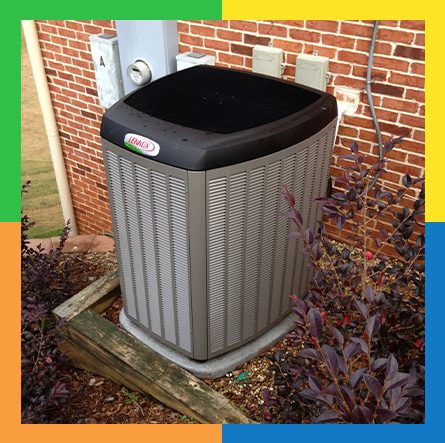As a building owner, you have a lot to customize within your structure, and your AC is among your options. Understanding how your AC works gives you timely insights into when to contact a professional about the lags that your cooling undergoes. Soon, you’ll come to understand how your air conditioning works and how it can be upgraded. This overview gives you the basics of central AC. You might appreciate the work of your technicians a bit more when you’re finished.
We discuss topics of central AC with our clients because of its convenience. Unlike your options with individual units in interior spaces, a central system with a particular point where air enters and cools, is what distributes AC throughout an entire building. Keeping this system “central,” or in one place, lets technicians fix AC problems with greater ease. Additional factors to consider are the peripheral vents and exhausts helping to move cool air throughout your interior.
You can choose to install a thermostat by your central unit or somewhere more convenient in your building. Here’s a better look at the major components that make central AC systems work in Alpharetta, Georgia.
The Art of Removing Heat
When we think about AC, many of us think solely about the results, but the term “air conditioning” is really about removing heat from the air and not about putting chill into the air. Think of air cycling in a home, entering through an intake and exiting back via a release. That air has a temperature, and the job of your AC is to catch heated particles from it. Those particles, as air moves and enters mechanical ventilation, are taken out of the air, leaving them at a lower temp when blown out.
Lowering Humidity
Think about when a mounted AC becomes wet, collecting water on its bottom and sides. The presence of condensation is the presence of humidity. The same is true when condensation collects on your windows although you’re using the air conditioner. Central air conditioning relies on special gases to control humidity, so condensation should never actually be seen. Modern ACs remove humidity by default, and here’s what we can avoid by having lower humidity:
- Mold: The drier your air is, the less likely it will collect mold spores or enable them to live.
- Condensation: Windows that are covered in moisture are a problem that you manage by lowering humidity.
- Allergies: Whether seasonal or not, the particles of dust in the air can build up when humidity levels are high.
- Respirations: Some will even have trouble breathing if their bronchi receive too much direct humidity while indoors.
Converting Gasses to Liquids
At the core of modern air conditioning is a chemical process that converts liquids to gasses and vice versa, and this is what provides us with what we think of as AC. Interestingly, by introducing heat into your AC unit, we use it to later lower air temps. Air conditioning requires some heat to convert liquids into gases. In converting liquid, the gas that forms attracts heated particles from its environment. This gas then converts back into a liquid in order for air to be cooled as it condensates.
Refrigerants and the Role They Play
Refrigerants are convertible liquids that change from liquid to gas with relative ease. Though your AC uses multiple parts and phases, it relies on refrigerants to cycle through the entire refrigeration process. The “re” in “refrigerant” helps us to see how this liquid behaves, being cooled down and then cycled back to higher temps just to be cooled again. This continuous cycle means that refrigerants, though they can be replaced, work to keep you cool indefinitely.
Keep in mind that there are different refrigerants to try. Speak with our reps to determine the regulations in your neighborhood and which solutions are ideal. Today, central ACs are so efficient that you can expect to reuse the same refrigerant without replacing it. Only when an unexpected leak occurs do replacements or repairs, being rare, become a necessary option.
The Compressor
The compressor is a pump that pressurizes refrigerants as a way of intaking gas and converting it to a liquid. As its name might imply, this machine “presses” your refrigerant and thus reduces its volume. When any gas is compressed this way, it absorbs heat; when that gas is released from its pressure, cooler temps come about. Repeating this process is significant and requires a compressor with a pump to push in more gas refrigerants for pressurization.
The Condenser Coil
The container your refrigerants are stored in they are liquids is called a condenser coil. It looks like a spiraled copper pipe. Though shaped as a spiraling cylinder, its hollow tubing is where AC fluids are stored. The condenser removes heat from any air particles passing over it. Particles around the condenser coils get drawn inward as the compressor reduces the volume of gases inside of its chamber. This compression is what absorbs the heat sitting in your interior spaces. Once the compressor releases its pressure, the heat it absorbs is converted into cooler air.
The Evaporator Coils
Since the condenser coil is what pressurizes refrigerants, thus releasing heat, the evaporator coil is used to then collect any unconverted heat away. These coils are also tubular, allowing any refrigerants that evaporate from the prior condenser coil to be collected as gasses. Refrigerants from the compressor enter the evaporator coils in order to absorb additional heat sitting in your home. This enables you to manage humidity while removing every heated particle in the air.
Coil Fans
Your central air conditioning unit relies on extensive ductwork or what are called coil fans. The coils of an AC unit are what ultimately intake hot air to release it as cold air. Fans, when engineered accordingly, are placed to distribute cool air around or to intake atmospheric air when initiating a cooling cycle. Air is cooled as it passes the coils and then is sent via a vent in a set direction. For larger spaces or bigger units, ducts might be the most suitable option for you.
Airflow
Ventilation also plays a role in how well your AC distributes cool air. Through a system of vents, fans and ducts, mechanical ventilation is one of the core options that building owners can use to spread cool air faster. A duct is a type of shaft that runs vertically or horizontally, depending on where it receives air from or takes it to. The actual openings of a duct system are called air vents, which consist of both supply and return vents. Mechanical fans can also be used to pressurize air in a specific direction.
Don’t be overwhelmed by the complexity of simple air conditioning. [company_name] is ready with a team of professionals leading a full-service package for central AC in Alpharetta, Georgia. Whether it’s your maintenance, repair, or installation needs, here and now is when to book a consultation. Our reps are eager to speak to get your AC running, so contact us about that today.










